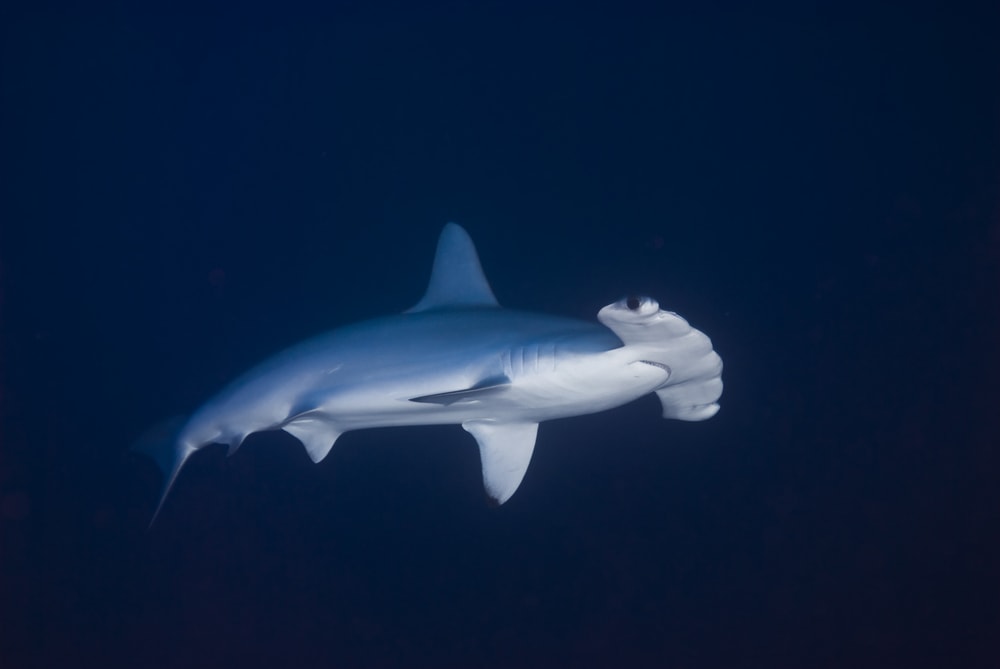Outforia Quicktake: Key Takeaways
- Scalloped hammerheads are named for the scallop-like shape of their hammer-shaped heads and are listed as critically endangered mainly due to fishing.
- They naturally inhabit deep open waters and can be found throughout the Atlantic, Indian, and Pacific Oceans.
- These sharks have unique movement patterns, spending their nights in the deep ocean and their days in shallow coastal waters, with females often forming large social groups.
- Scalloped hammerheads are carnivorous, eating fish, cephalopods, crustaceans, and smaller sharks and rays, and have a lifespan of up to 55 years.
The scalloped hammerhead is one of ten species of hammerhead sharks. Nine of the species, including the scalloped hammerhead, are part of the genus Sphyrna. One species belongs to the genus Eusphyrna.
These type of sharks are unique from other hammerheads because of the shape of their head. Their hammer-like head has curves that make them resemble the shell of a scallop.
Scalloped hammerheads have interesting daily lives; they are always moving. They spend their nights in the deep open ocean and their days in shallow coastal waters.
They are solitary during portions of their lives. Yet, the females often like gathering in large schools.
Unfortunately, the targeting of scalloped hammerheads leaves these sharks critically endangered.
You May Also Like: Dive Into The Ocean: Full Guide To All 33 Types Of Seals
What Are Sharks?
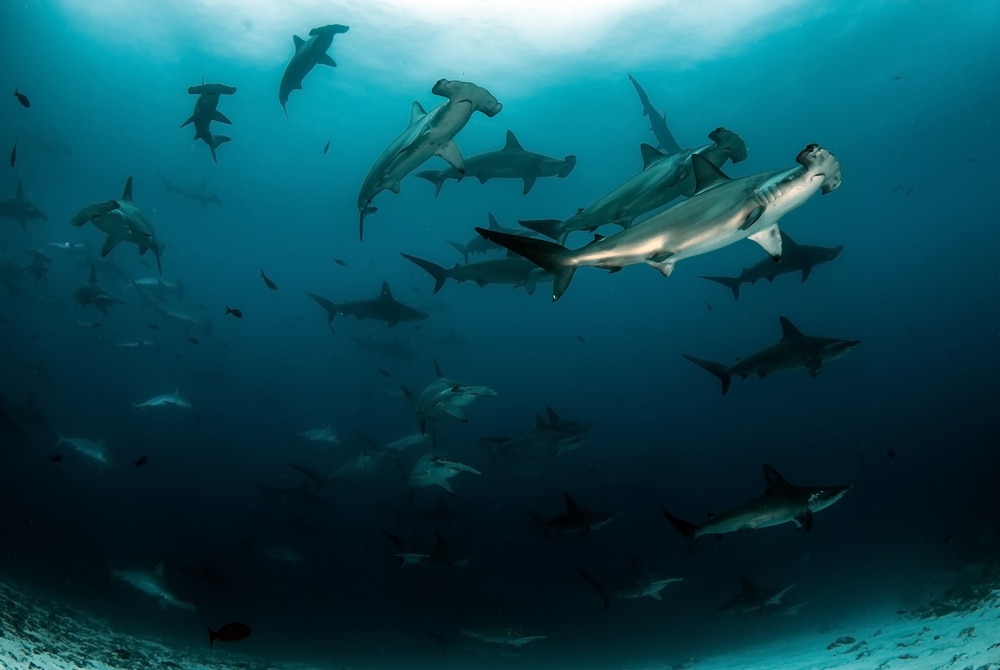
Sharks are a type of fish, though they have cartilaginous skeletons rather than bony ones.
There are over 500 types of sharks around the world.
Sharks are one of the oldest species on the planet, having been around for over 400 million years.
Some of the smallest sharks only reach 7 in (17.8cm) in length. The largest can grow to be 32.8 ft (10m) long.
Sharks differ from other fish due to their number of gill slits. Most fish only have one to two gill slits on each side of their heads, but sharks have five to seven. Having more gill slits allows sharks to be more efficient at absorbing oxygen.
One of the most well-known characteristics of sharks is their mouths full of many rows of teeth. Some sharks have triangular teeth with sharp points. Others have broader teeth with serrated edges made for shredding.
Scalloped Hammerhead Sharks — What Are They?
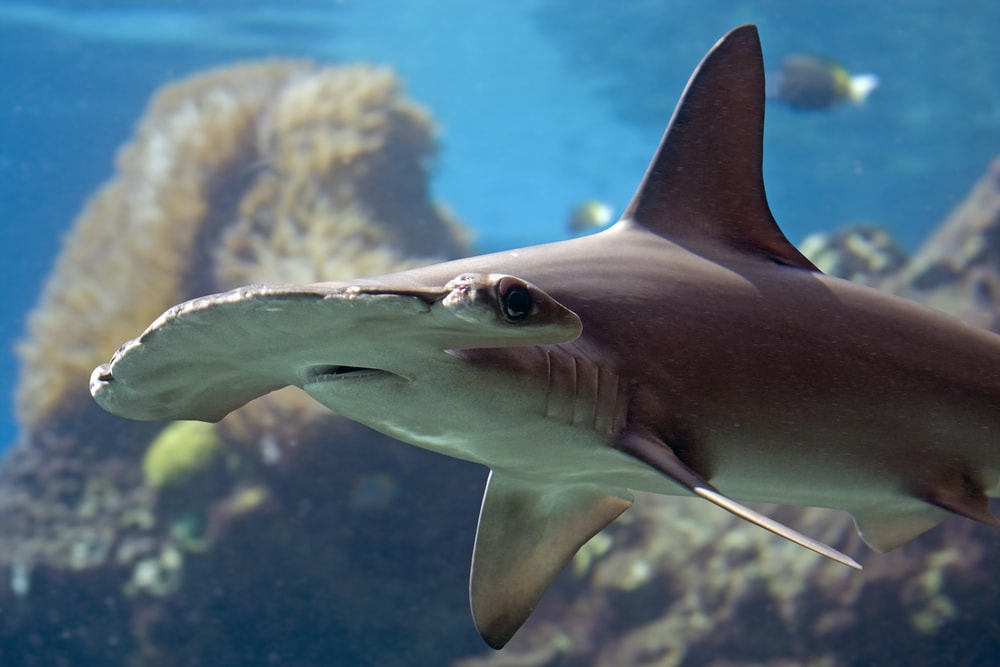
Scalloped hammerhead sharks (Sphyrna lewini) get their name because of their hammer-shaped heads.
The “scallop” part of their name comes from the notch at the center and the grooves at the edges of their heads. The edges of their heads are thin and turn backward in a wing-like shape.
They have an eye that sits at the end of each head positioned alongside its nostrils. Such a position gives them a unique view that may help them to turn more quickly than other shark species.
Scalloped hammerheads have darker coloration on the upper part of their body. Their undersides are white.
The contrasting colors help camouflage the shark to its prey. Fish swimming below them look up, and the shark’s white underside blends in with the sunshine. Fish swimming above them look down, and the shark’s dark upper body blends in with the depths of the ocean.
They have two dorsal fins. The first one is larger, is more curved, and has a round tip. The second dorsal fin is slightly concave at the back edge.
The pectoral fins are also slightly rounded, and the tips are dark gray or black.
Their tail fin, or caudal fin, has two unevenly-sized lobes.
Sexual Dimorphism
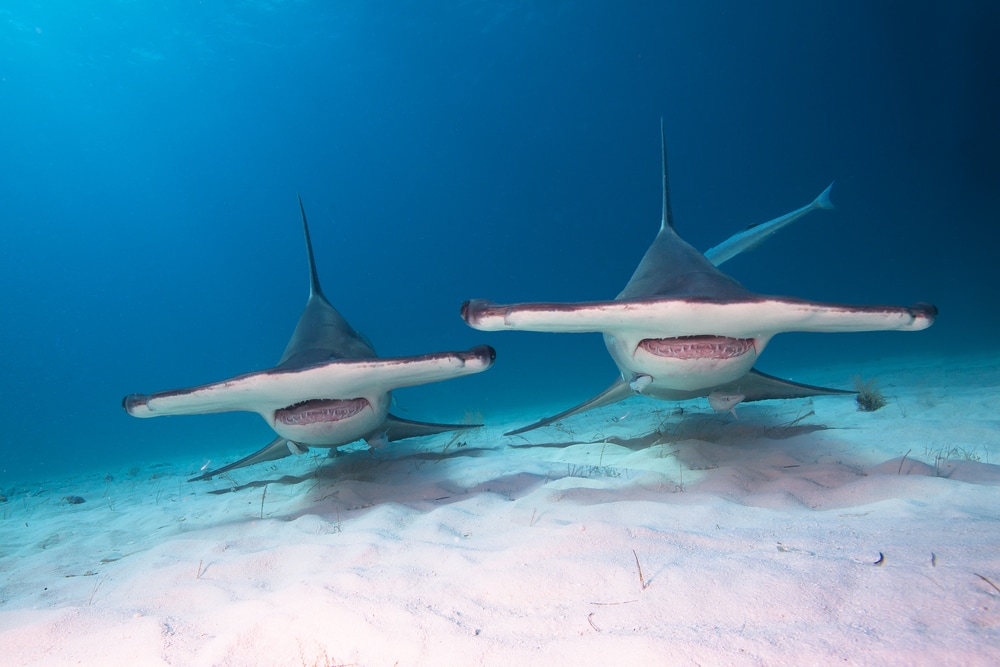
It is easy to tell males and females apart.
Males are smaller, growing to lengths of up to 6 ft (1.8 m) and weighing up to 64 lbs (29 kg).
Females can reach lengths of more than 8 ft (2.4 m) and can weigh up to 80 lbs (36.3 kg). The largest known female was 14 ft (4.3 m) in length.
Males have a pair of claspers. Claspers are external reproductive organs that they insert inside the female for fertilization. The females lack claspers, instead having internal oviducts.
Where Do Scalloped Hammerhead Sharks Live?
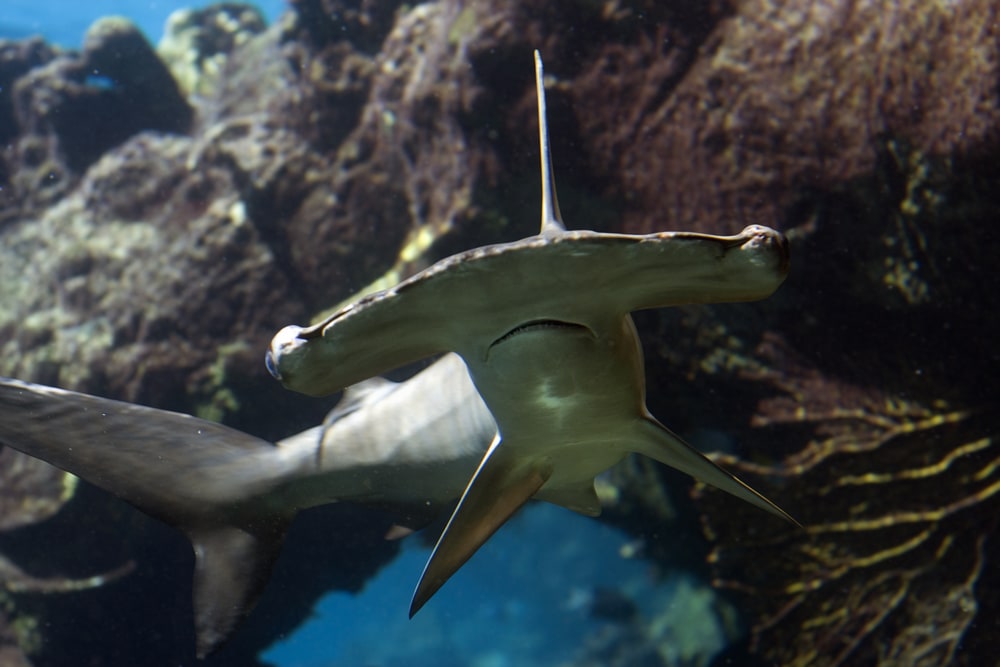
Their natural habitat primarily comprises deep open waters. Scalloped hammerheads live throughout the Atlantic, Indian, and Pacific Oceans.
They sometimes go into coastal waters along continental and island shelves. Onlookers even see them travel into estuaries and bays near the coast.
Movement Patterns
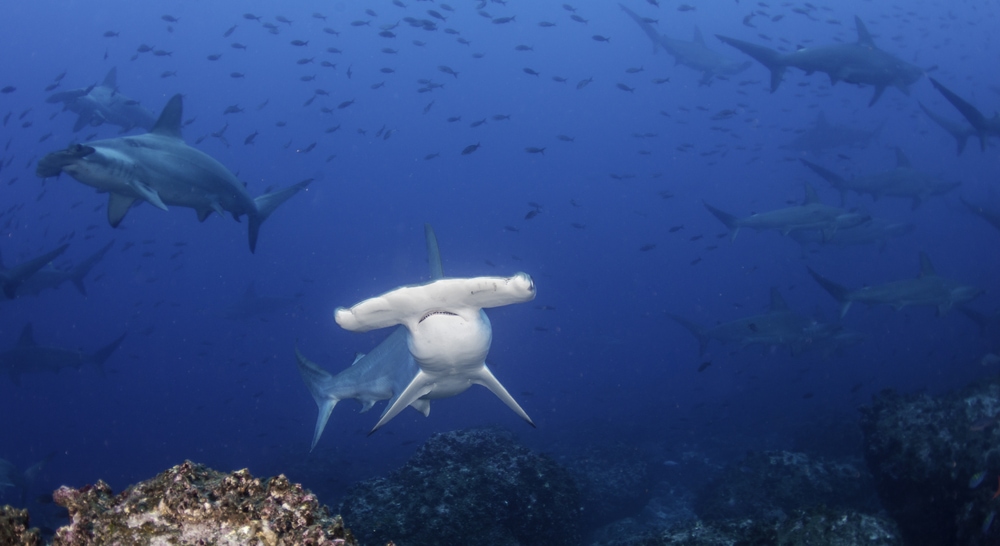
Scalloped hammerheads change up their living spaces throughout the day.
They spend the nighttime in the deep waters of the open ocean where they hunt. They travel closer to land during the day.
At dawn, they move inland to the continental shelves, bays, and estuaries.
As the day goes on, they move to the drop-off zones and reefs just outside the continental shelves. The females socialize in these areas in groups.
When the sun goes down, scalloped hammerheads move back to the open ocean.
How Do Scalloped Hammerhead Sharks Behave?
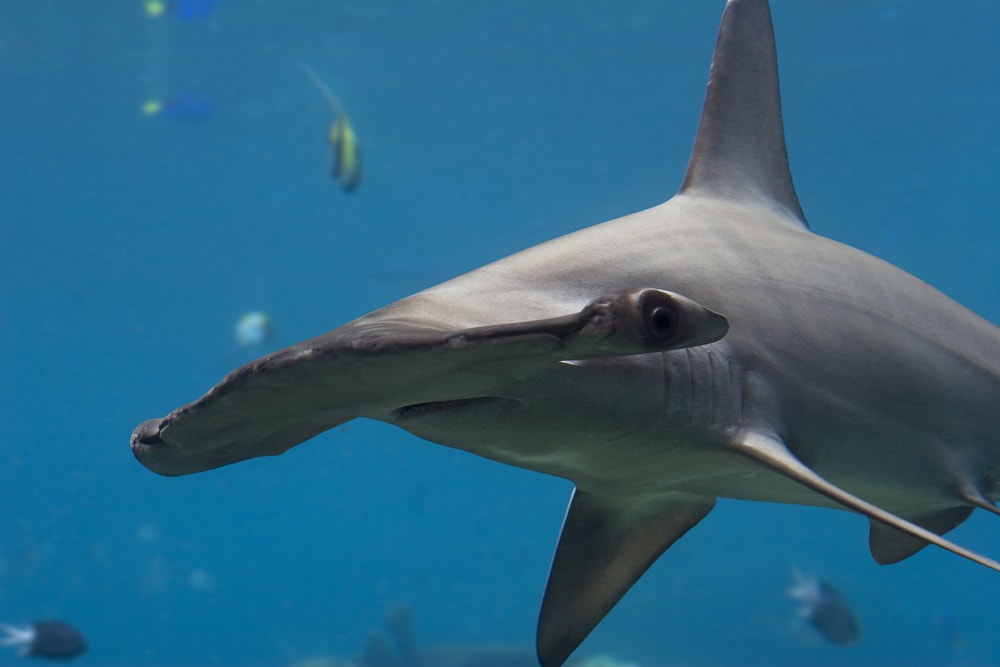
Scalloped hammerheads have excellent vision and can detect chemicals in the water. They have “Ampullae of Lorenzini.” These are electrical receptors that help with navigation and locating prey.
The Ampullae of Lorenzini are on the underside of their snout and “hammer”. The large size of their heads allows them to sense prey hiding under the substrate.
Pacific scalloped hammerheads have their own unique method of navigation.
They use their electrical receptors to sense cooled magma. Magma comes from the floor of the ocean along the mid-ocean ridge.
The magma has strong magnetic signals. The signals allow the sharks to follow the ocean floor’s geological fault lines.
Social Behaviors
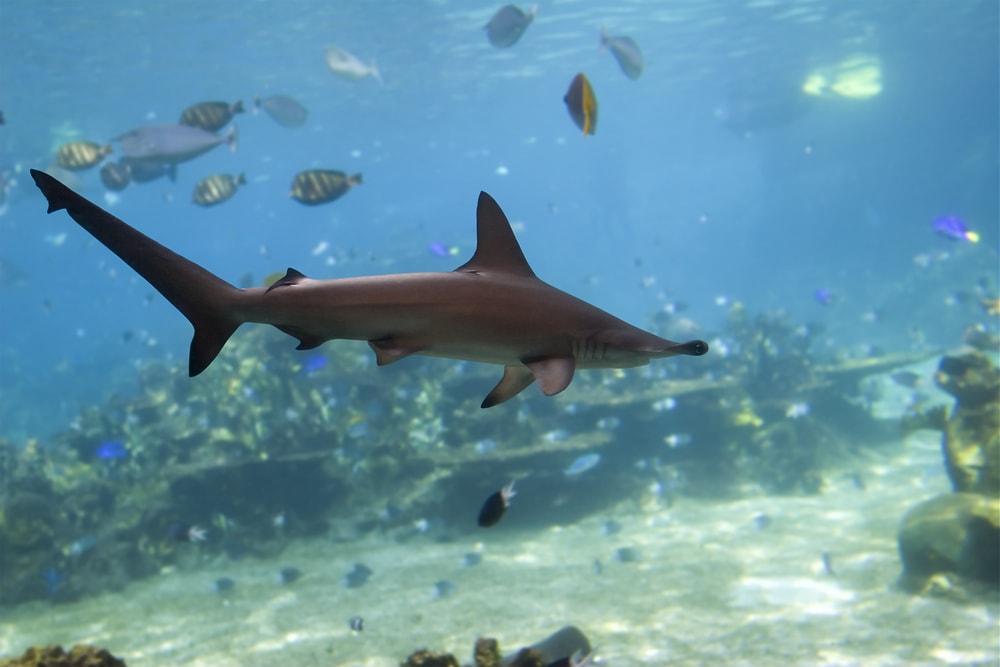
Female scalloped hammerheads commonly form large social groups. Males rarely enter these groups except when seeking a mate.
These large groups keep the sharks safe from predators. Unfortunately, they also make them easier targets for fishing.
The groups may sometimes comprise more than 100 individuals.
During other parts of their lives, scalloped hammerheads prefer to be solitary.
You May Also Like: 16+ Strongest Bite Force In The Animal Kingdom
How Do These Sharks Communicate?
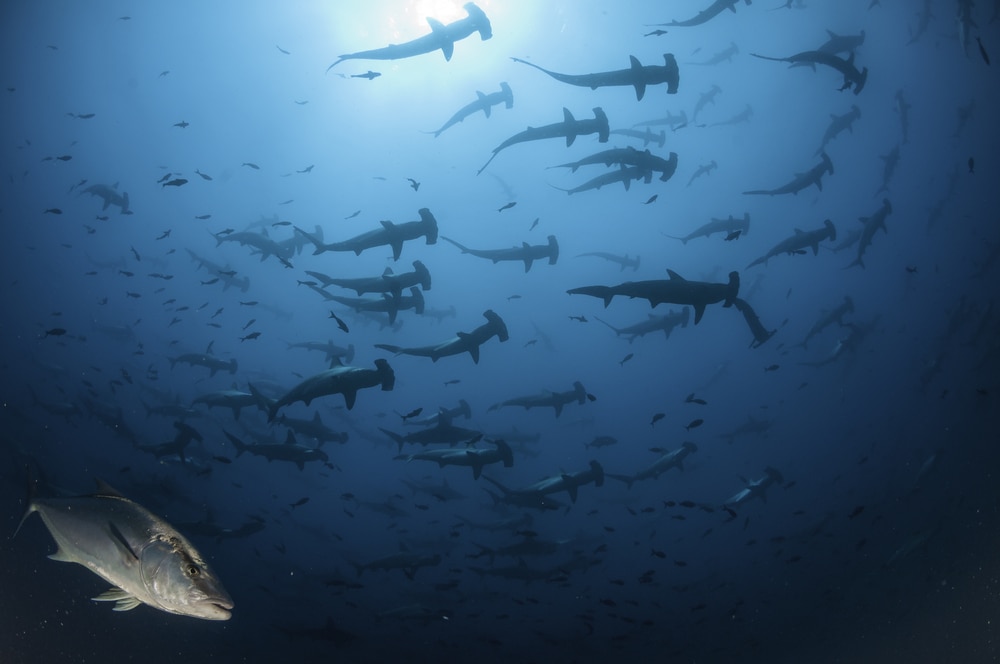
Scalloped hammerheads display submission and dominance over other members of their species.
Sharks displaying dominance swim in an upward pattern, like a corkscrew.
Those displaying submission shake their heads quickly from side to side.
You may also like: The Remarkable Lemon Shark: Gentle Giants Of The Sea
What Do Scalloped Hammerheads Eat?
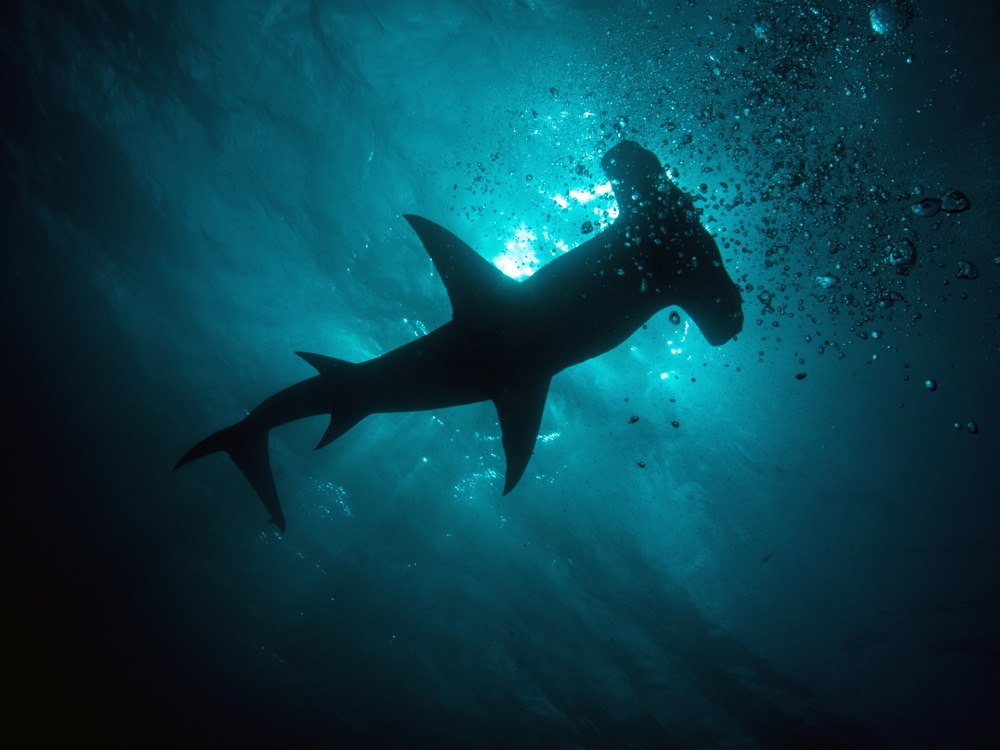
Like all sharks, scalloped hammerheads are fierce carnivorous predators.
Juveniles tend to hunt closer to shore where they eat bottom-dwelling fish.
Adults feed in deeper waters. They hunt fish, cephalopods, crustaceans, and smaller sharks and rays. Individuals living in the Indo-West Pacific even eat sea snakes.
Hunting Strategies
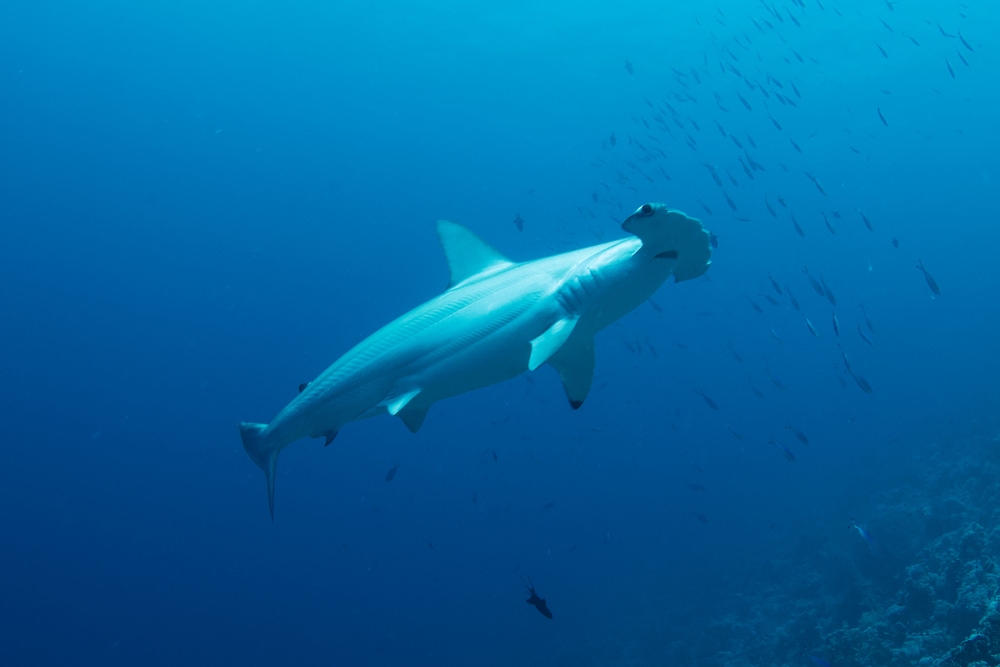
These sharks hunt at night and swim rapidly at the prey before grabbing it. They may swallow the animal whole after pouncing, or they may bite it hard enough to severely injure it.
The shape of their head gives them an advantage in capturing prey. Their eyes and nostrils are widely spaced apart. The spacing allows them to easily sense things on both sides of their bodies.
Eating Stingrays
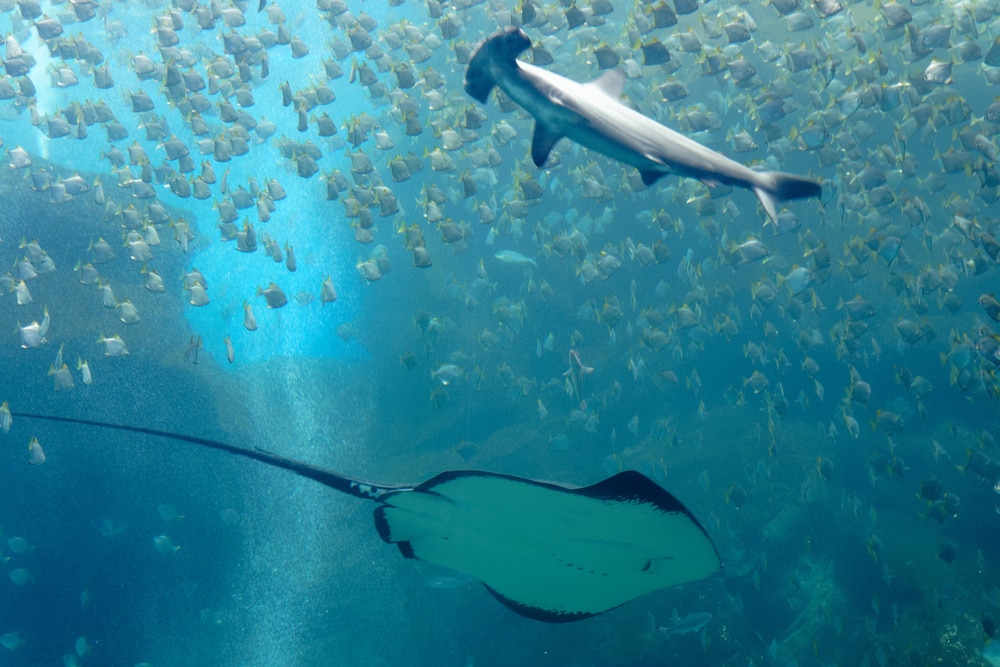
A different species, the great hammerhead, uses the sides of its head to pin stingrays to the sea floor. Researchers speculate that scalloped hammerheads may do the same thing.
Regardless of how they capture them, scalloped hammerheads do eat stingrays. They do not seem to mind the stingray’s venomous barbs, though scientists aren’t sure how.
Researchers found one shark with 96 stingray barbs stuck around its mouth and head.
Digestive System
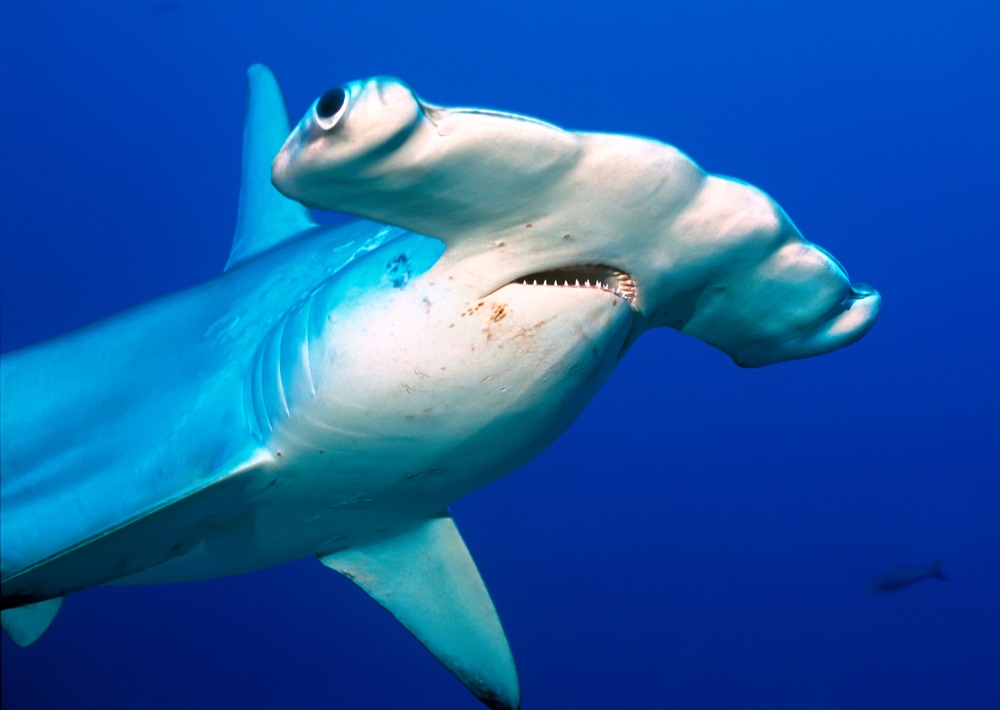
Sharks have an interesting digestive system. It offers better efficiency than most fish get.
When empty, their stomachs are “J” shaped and compact. Yet, their stomachs can expand considerably to accommodate an enormous amount of food.
Sharks swallow their food whole or bite it into large chunks. They don’t chew their food as many animals do. Expandable stomachs are necessary to hold large chunks of meat.
A shark’s stomach cannot digest bones, so sharks must spit them back up. The stomach prevents the bones from reaching the intestines. The opening to the intestines is too small.
A few species of sharks push their stomachs inside out through their mouths. Doing so makes it easier to purge their stomachs of bone and other indigestible material.
The saltwater washes the stomach clean. Then, the sharks pull their stomachs back inside their bodies.
Sharks have short intestines with internal valves. The valves increase the intestine’s surface area.
The increased surface area allows for easier passage through the digestive tract. The intestines are also very flexible to accommodate food of all shapes and sizes.
The internal valves slow the food down as it moves through the shark’s system. The slow-down of their digestion allows them to absorb more nutrients from their food.
How Do Scalloped Hammerheads Reproduce?
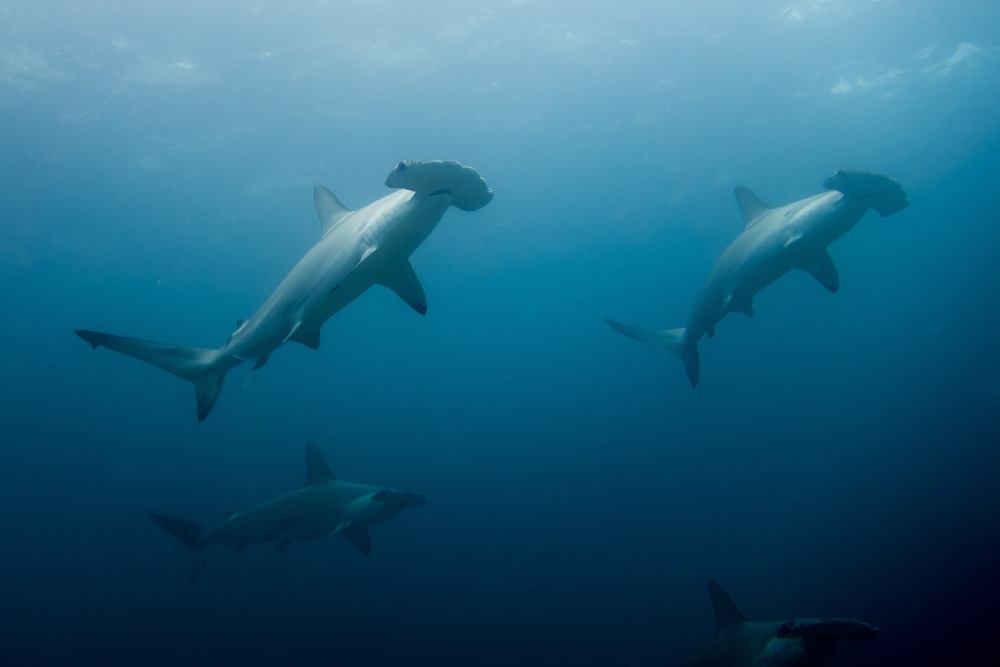
Scalloped hammerheads are slow to mature.
Females typically become sexually mature between 15 and 17 years of age when they are about 6.6 ft (2 m) long.
Males reach sexual maturity much faster at about six years of age and with a body 4.9 ft (1.5 m) long.
Mating Behaviors
Scientists still need to observe scalloped hammerheads more to understand their mating behavior.
When it’s time to mate, adult males travel to deep waters to look for females.
Females tend to be quite social and travel in schools. A male will locate one of these schools and infiltrate it, swimming in an “S” pattern. Doing so tells the females that he’s ready to mate.
The “S” pattern pushes away younger females who may not be sexually mature.
The younger females tend to travel at the edges of the school, while the older females stay at the center.
Fertilization
When a female indicates that she’s ready to mate, the male bites her pectoral fin to prevent her from getting away. He curls his tail around her body and twists himself in a way that aligns their genitals.
Then, he puts one of his claspers inside her oviduct to deposit the sperm. As they mate, the pair sinks further into the water.
The Pups
Scalloped hammerheads birth live young who develop inside their mother’s bodies. They have a yolk-sac placenta. The placenta attaches them to their mother’s uterus and provides them nourishment.
Female scalloped hammerheads have two uteruses. The placenta may attach the pup to either.
Gestation lasts for nine to ten months, and a female can produce 12 to 38 pups. At birth, the pups are only 15-17.7 in (38-45 cm) long.
After birth, the pups remain in large schools until adulthood for protection. They stay near the coast in their nursery areas for several years until they are big enough to leave. Despite living in schools, they usually hunt for food on their own.
The parents provide no care for their young after birth.
How Long Do Scalloped Hammerheads Live?
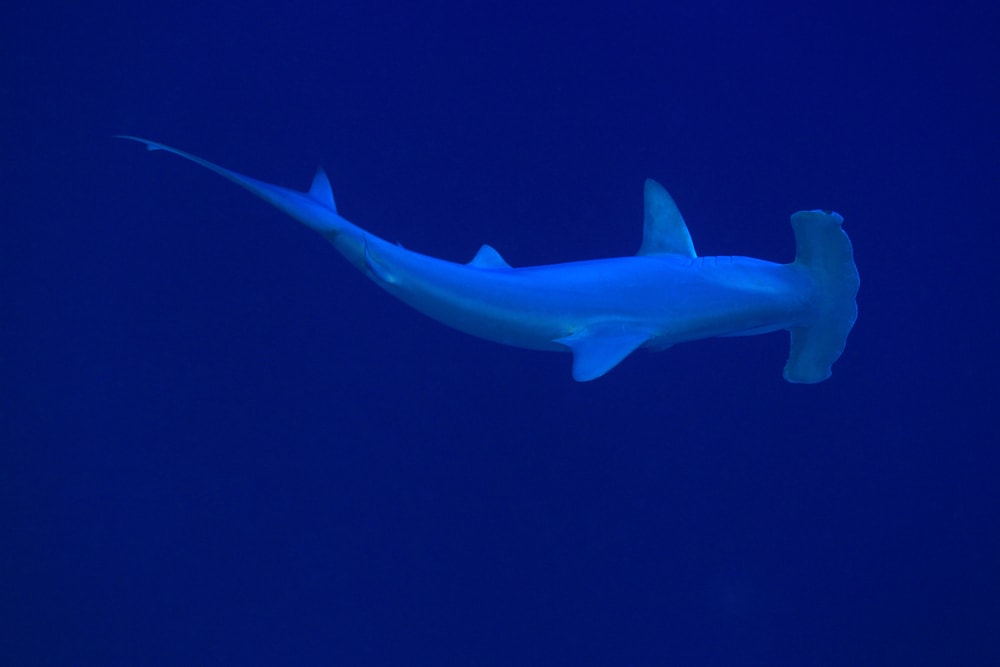
Scalloped hammerheads are a long-lived species. Researchers believe that the greatest lifespan of these sharks is 55 years.
The oldest scalloped hammerhead ever caught was 31.5 years old.
Yet, in a different study, the oldest shark caught was only 10.5 years old.
Do Scalloped Hammerheads Have Any Predators?
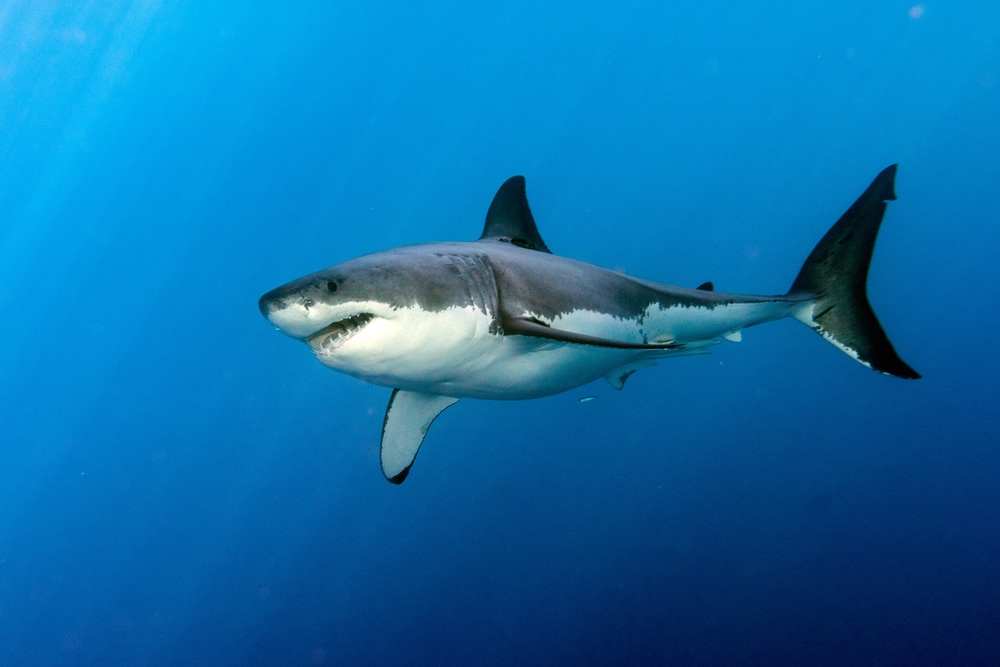
Scalloped hammerheads have few predators since they are at the top of the food chain in their range.
Yet, larger species sometimes prey on scalloped hammerheads. Tiger, great white sharks, and orcas are predators of scalloped hammerheads.
You May Also Like: 10 Keystone Species Examples And The Important Role They Play In Every Ecosystem
Conservation
The International Union for the Conservation of Nature (IUCN) assessed scalloped hammerheads. They list them as “critically endangered” with a “decreasing” population trend.
The biggest threat to these sharks is fishing.
Most of the sharks are victims of bycatch in commercial fishing in deep ocean waters. They are sometimes caught in longlines, trawls, and gill nets. Sharks are often injured during these accidental catches and die when put back in the water.
Targeted fishing is also a major problem. Many cultures prize these sharks for their meat and fins.
In 2012, hammerheads were 6% of the victims of the fin trade in Hong Kong. Population estimates show that fishers catch 1.3 to 2.7 million hammerheads every year. This estimate is only for sharks caught for their fins. The total number is likely much larger.
People use their skin for leather and their liver oil for medicinal purposes. Fisheries likely underreport the number of sharks they take. The industry is also underregulated.
You may also like: Goblin Sharks: Secrets Of The Depths’ Most Bizarre Predators
Scalloped Hammerheads FAQs
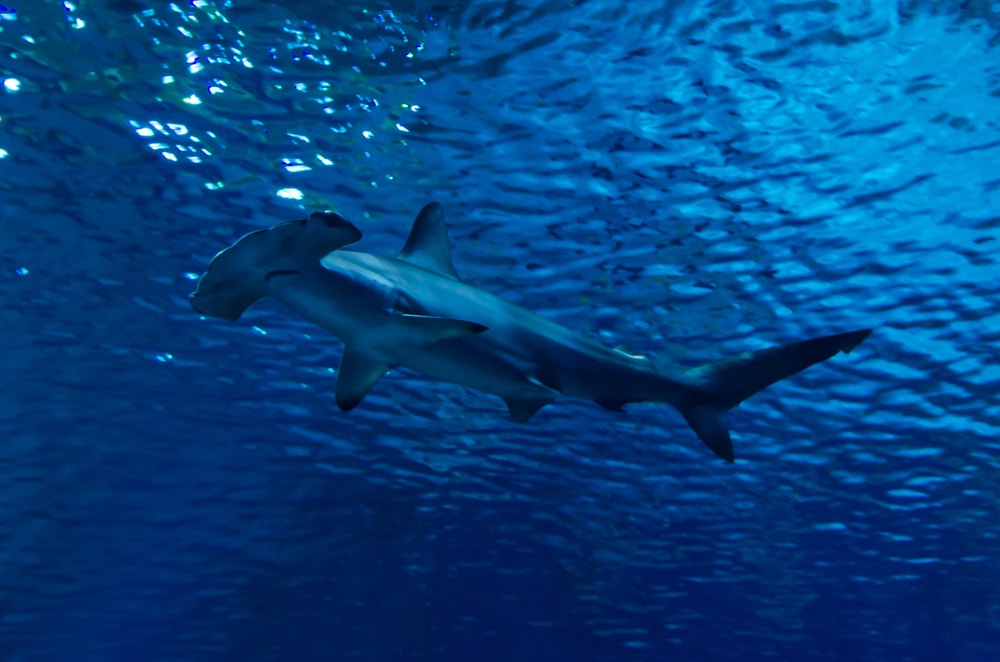
Why Are They Called Scalloped Hammerheads?
Scalloped hammerheads get their name because of the wave-like pattern along their heads. They have a deep notch at the center of their head and many grooves along the length.
The general name “hammerhead” comes from the hammer-like shape of their head. The scalloped hammerhead is only one of ten hammerhead species.
Are Scalloped Hammerhead Sharks Aggressive?
Scalloped hammerheads are aggressive animals like most sharks. Governments consider them a threat to human safety. Yet, there are no confirmed attacks.
These sharks are shy and avoid people, which is why they are so difficult to research.
Their mouths are very small compared to their body size. The largest animals they eat are small sharks and stingrays. This characteristic makes it even more unlikely that they will attack humans.
There are reports of scalloped hammerhead bites. But, there has been no confirmation of these reports.
Do Great White Sharks Eat Hammerhead Sharks?
Great white sharks eat scalloped hammerheads; they are one of their only predators.
Scalloped hammerheads are large, top predators in their range.
Still, great white sharks are larger and fiercer and will sometimes go after them. Other predators include tiger sharks and orcas.
More from Outforia:
Interested in learning more about sharks? Check out these Outforia articles!
Sharks In Florida | Sharks In Hawaii | Sharks In Maui | How Do Sharks Mate? | Are Sharks Mammals? | How Long Do Sharks Live? | Sharks In Lake Michigan | Do Sharks Have Bones?



